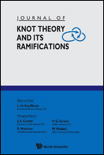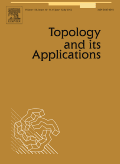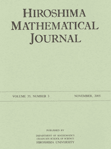
JOURNAL OF KNOT THEORY AND ITS RAMIFICATIONS
Scope & Guideline
Bridging disciplines through the study of knots.
Introduction
Aims and Scopes
- Knot Invariants and Their Applications:
Research on various knot invariants, including quantum invariants, polynomial invariants, and homological invariants, is a core focus. The journal highlights studies that not only develop new invariants but also explore their applications in distinguishing different types of knots and links. - Topological and Geometric Aspects of Knots:
The journal emphasizes the geometric and topological properties of knots and links, including studies on their embeddings in three-dimensional spaces, Heegaard splittings, and the relationships between knot theory and manifold topology. - Virtual Knot Theory:
A significant area of research is dedicated to virtual knot theory, which extends classical knot theory to include virtual knots and links. This encompasses the study of virtual crossing diagrams, invariants for virtual knots, and their applications in broader mathematical contexts. - Categorification and Higher Structures:
The journal features research on categorification in knot theory, where authors explore the relationships between knot invariants and higher algebraic structures. This includes studies on Khovanov homology, categorified invariants, and their implications for classical knot theory. - Interdisciplinary Connections:
The journal encourages submissions that connect knot theory with other areas of mathematics, such as algebraic topology, representation theory, and combinatorial structures. This interdisciplinary approach fosters a broader understanding of knots and links within the mathematical landscape.
Trending and Emerging
- Virtual and Welded Knots:
There is a growing interest in virtual and welded knot theories, with numerous papers exploring their properties, invariants, and classifications. This trend highlights the community's shift towards understanding knots beyond classical constraints. - Algebraic and Combinatorial Approaches:
Research utilizing algebraic structures such as quandles, braids, and group theory to study knots and links is on the rise. This trend emphasizes the importance of combinatorial techniques and algebraic invariants in knot theory. - Applications of Machine Learning and Data Science:
An emerging theme is the application of machine learning techniques to knot theory, particularly in understanding knot invariants and classifications. This innovative approach illustrates the intersection of computer science and mathematics in advancing knot theory. - Higher Dimensional Knot Theory:
There is an increasing focus on higher-dimensional analogs of knot theory, including studies on knotted surfaces and higher-dimensional manifolds. This trend signifies a broadening of the research scope to include more complex topological structures. - Categorification and Topological Field Theories:
Research on categorification of knot invariants and its connections to topological field theories is gaining momentum. This trend reflects a deeper exploration of the relationships between knot theory and advanced algebraic concepts.
Declining or Waning
- Classical Knot Theory:
Although classical knot theory remains relevant, there has been a noticeable decline in papers focused solely on traditional knot types and their properties. Instead, the research is increasingly oriented towards virtual knots and algebraic aspects. - Elementary Knot Moves and Diagrams:
Research centered around elementary moves on knot diagrams, such as Reidemeister moves or basic diagrammatic techniques, has seen a reduction in frequency. The trend seems to favor more complex interactions and higher-dimensional constructs. - Basic Applications of Knot Theory:
Submissions that address only the fundamental applications of knot theory, such as those related to physics or biology without deeper mathematical implications, appear to be less frequent. This indicates a preference for studies that provide rigorous mathematical frameworks rather than basic applications.
Similar Journals

ANNALS OF GLOBAL ANALYSIS AND GEOMETRY
Charting New Territories in Global Mathematical ResearchANNALS OF GLOBAL ANALYSIS AND GEOMETRY, published by Springer, stands as a prominent periodical in the fields of analysis and geometry, holding esteemed positions in the academic community with a consistent record since its inception in 1983. With an ISSN of 0232-704X and an E-ISSN of 1572-9060, this journal provides a platform for high-quality research articles that delve into the intricate relationships between geometric constructs and analytical methods. Despite the lack of open access, the journal's influence is noteworthy, evidenced by its 2023 category quartiles, achieving Q2 rankings in both Analysis and Geometry and Topology, and notable contributions to Political Science and International Relations as well. Its Scopus rankings further illustrate its impact, placing it at rank #60 in Geometry and Topology and #132 in Analysis within a competitive academic landscape. Researchers, professionals, and students alike will find ANNALS OF GLOBAL ANALYSIS AND GEOMETRY an invaluable resource for cutting-edge discoveries and scholarly discussions that push the boundaries of knowledge within these critical fields.

Selecta Mathematica-New Series
Elevating Mathematical and Physical Sciences.Selecta Mathematica-New Series is a premier academic journal published by Springer International Publishing AG, based in Switzerland. With an impressive impact in the fields of Mathematics and Physics, it is recognized in the Q1 category for both Mathematics (Miscellaneous) and Physics and Astronomy (Miscellaneous) as of 2023. Established in 1995, the journal provides a platform for rigorous peer-reviewed research, facilitating the dissemination of groundbreaking findings and theoretical advancements through its converged publication years up to 2024. Researchers and scholars seeking to stay at the forefront of mathematical and physical sciences will benefit from the journal's diverse scope and high-impact articles. Although it does not operate under an open-access model, Selecta Mathematica-New Series remains a vital resource for building knowledge and fostering collaboration among professionals and students engaged in these dynamic fields. Access to its content is essential for those aiming to deepen their understanding and contribute to the ongoing dialogue within the scientific community.

TOPOLOGY AND ITS APPLICATIONS
Unveiling New Dimensions in Topological StudiesTopology and Its Applications is an esteemed journal within the field of mathematics, specifically focusing on topology and its various applications. Published by Elsevier, it serves as a significant platform for researchers, professionals, and students interested in the intersection of geometry and topology. The journal has been operational since 1980 and continues to contribute to advancements in the field with its broad scope that encompasses theoretical developments and practical applications. With an impact factor that reflects its importance in the academic community, it currently holds a Q3 ranking in Geometry and Topology as per the 2023 category quartiles. The journal is indexed in Scopus, ranking #59 out of 106 in its category, which places it within the 44th percentile among other publications. Although it does not offer open access, it remains a vital resource for those engaged in cutting-edge topology research. Researchers looking to engage with innovative studies and contribute to ongoing discussions in this dynamic field will find this journal indispensable.

Communications in Number Theory and Physics
Pioneering Research at the Confluence of Two DisciplinesCommunications in Number Theory and Physics is a leading academic journal published by INT PRESS BOSTON, INC, dedicated to the exploration of the intersections between number theory and physics. Since its inception in 2007, the journal has established a reputation for excellence, evidenced by its 2023 rankings placing it in the Q2 category within the fields of Algebra and Number Theory, Mathematical Physics, and Physics and Astronomy (Miscellaneous). With an ISSN of 1931-4523 and an E-ISSN of 1931-4531, the journal facilitates valuable peer-reviewed research, making substantial contributions to both theoretical and applied aspects of its core disciplines. Recognized for its prominence within the academic community, it holds notable Scopus rankings, highlighting its influence and quality of published work. Communications in Number Theory and Physics serves as an essential platform for researchers, professionals, and students, fostering scholarly dialogue and advancing knowledge at the intersection of mathematics and physics.

Homology Homotopy and Applications
Pioneering Research in Homology and HomotopyHomology Homotopy and Applications is a prestigious peer-reviewed journal published by INT PRESS BOSTON, INC, dedicated to advancing the field of mathematics, particularly within the realms of algebraic topology, homological algebra, and their applications. With an impressive Q1 classification in the mathematics category for the year 2023, this journal serves as a crucial platform for researchers, professionals, and students aiming to disseminate their findings in a rapidly evolving discipline. Although open access options are not currently available, the journal retains significant value with its rigorous selection process and high-impact studies. The journal invites submissions that explore theoretical developments as well as practical applications that bridge homology and homotopy theories, thus contributing to the broader scientific community from its base in the United States. With convergence covering years from 2001 to 2024, Homology Homotopy and Applications continues to be a vital resource for fresh insights and groundbreaking research in mathematical sciences.

New York Journal of Mathematics
Empowering discovery through open-access mathematics.New York Journal of Mathematics is a prominent open-access journal, published by the ELECTRONIC JOURNALS PROJECT, dedicated to advancing the field of mathematics through the dissemination of groundbreaking research. Since its inception in 1996, the journal has evolved into a valuable resource for researchers, educators, and students, particularly in the realm of general mathematics. As of 2023, it proudly holds a Q2 classification in the Mathematics (miscellaneous) category, reflecting its growing impact and reach within the academic community, despite being ranked at the 31st percentile overall. With its commitment to open access since 2022, the journal ensures that high-quality mathematical research is readily available to a global audience, fostering collaboration and innovation. Researchers interested in contributing to this dynamic field will find the journal a vital platform for sharing their findings and engaging with fellow mathematicians around the world.

Forum of Mathematics Sigma
Shaping the future of mathematics through rigorous scholarship.Forum of Mathematics Sigma is a premier open access journal published by Cambridge University Press that has been at the forefront of mathematical research since its inception in 2013. With a strong emphasis on advancing the fields of mathematics, the journal consistently achieves Q1 rankings across multiple categories, including Algebra and Number Theory, Analysis, and Computational Mathematics. This distinction highlights its impact and relevance within the scholarly community. The journal prides itself on providing a platform for innovative research, fostering collaboration among researchers and practitioners across various mathematical disciplines. Open access publication ensures that cutting-edge findings are widely available to readers globally, enhancing the dissemination of knowledge. With an address in the heart of Cambridge, England, Forum of Mathematics Sigma is dedicated to promoting high-quality research and making significant contributions to the development of mathematics.

Hiroshima Mathematical Journal
Fostering Scholarly Dialogue in MathematicsThe Hiroshima Mathematical Journal, published by Hiroshima University, Graduate School of Science, serves as a prominent platform for disseminating high-quality research in the field of mathematics. Established in 1959, the journal has been an integral part of the mathematical community, focusing on areas such as Algebra, Number Theory, Analysis, and Geometry and Topology. Although currently classified in Q4 quartile rankings within its categories, the journal is committed to advancing mathematical knowledge and fostering scholarly dialogue. Its accessibility, combined with its long-standing history, makes it an essential resource for researchers, professionals, and students dedicated to exploring and enhancing the mathematical sciences. For those interested in contributing or accessing cutting-edge research, the Hiroshima Mathematical Journal continues to uphold its mission of excellence in mathematical scholarship.

Algebraic and Geometric Topology
Connecting Algebraic Insights with Geometric PerspectivesAlgebraic and Geometric Topology, published by Geometry & Topology Publications, is a premier journal dedicated to the fields of algebraic and geometric topology. With its ISSN of 1472-2739 and a commendable Q1 ranking in 2023, this journal serves as a vital resource for top-tier research, showcasing groundbreaking developments and fostering discussions among mathematicians globally. Operating since 2007 and continuing through 2024, the journal is positioned within the United States and aims to deliver open access to the latest findings, promoting collaboration and innovation. As a significant contributor to the mathematical landscape, Algebraic and Geometric Topology appeals not only to researchers and professionals, but also to students eager to explore the rich interplay between algebra and topology, making it an essential read for anyone involved in advanced mathematical studies.

INTERNATIONAL JOURNAL OF MATHEMATICS
Innovating Research in the Realm of MathematicsInternational Journal of Mathematics, published by World Scientific Publishing Co Pte Ltd, is a leading academic journal dedicated to advancing research in the field of mathematics. With an ISSN of 0129-167X and an E-ISSN of 1793-6519, this journal provides a platform for the dissemination of high-quality mathematical research and fosters academic discourse among mathematicians and professionals worldwide. Operating out of Singapore, International Journal of Mathematics boasts a respectable Q2 ranking in the 2023 Mathematics (miscellaneous) category, indicating its commitment to impactful scholarship. The journal publishes articles that cover a broad spectrum of mathematical topics, ensuring valuable insights for researchers, educators, and students alike. Despite not being an open-access journal, it maintains accessibility through established university and institutional subscriptions, furthering its influence in the mathematical community. The journal has continually evolved since its inception in 1996 and will continue to be a crucial resource for insightful mathematical explorations until at least 2024.